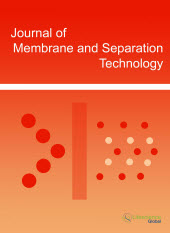jmst
|
|
Abstract: Novel liquid membrane system, which is named polymeric pseudo-liquid membrane was constructed from polymethacrylate derivative bearing oligodimethylsiloxane (PDMSMA), showing rubbery state under operating conditions, as a membrane matrix. In the present study, dibenzo-18-crown-6 (DB18C6), dibenzo-21-crown-7 (DB21C7) or O-allyl-N-(9-anthracenylmethyl)cinchonidinium bromide (AMCC) was adopted as a carrier for KCl transport, CsCl transport or optical resolution of racemic mixture of phenylglycine (Phegly), respectively. The results of KCl and CsCl transports revealed that the membrane transport was attained by carrier-diffusion mechanism like conventional liquid membranes. The present study led the conclusion that PDMSMA can be applicable not only to membrane transport of alkali metal ions, such as K+ and Cs+, but also to chiral separation. Keywords: Chiral separation, Crown ether, Liquid membrane, Optical resolution, Polymeric pseudo-liquid membrane. |
|
|
Abstract: The mass transfer rate of catalytic recovery of sulfur is investigated, enters through the catalyst-membrane interface (layer), accompanied by pseudo-first order irreversible reaction. Reaction kinetics is measured considering the system as a homogeneous system due to the consideration of mixed flow patterns of the reacting fluids, though the catalysis is a heterogeneous one. The multi-reactant mass transfer behaviour of the catalytic membrane reactor (CMR) is also studied on the basis of Maxwell-Stefan theory to understand the diffusion of reactants inside the membrane reactor. The mass transport behaviour and the performance of the fabricated CMR are strongly influenced by the reaction conditions, such as, reaction equilibrium constant (Keq) and membrane properties, namely, membrane area and reactor volume. An intermediate value with asymptotic nature of Keq as a function of time indicates appreciable performance of the catalytic membrane. On the other hand, the minimum value of kij indicates a negligible effect on mass transfer over the reactor performance. Keywords: Polymer, membrane, gas separation, permeability, permeance, selectivity. |
|
|
Abstract: The purpose of this work is to combine negative air ions (NAIs)and mechanical filters for removal of indoor suspended particulates. Various factors, including aerosol size (0.05-0.45 μm), face velocity (10 and 20 cm/s), species of aerosol (potassium chloride and dioctyl phthalate), relative humidity (30% and 70%), and concentrations of NAIs (2 ´ 104, 1 ´ 105, and 2 ´ 105 NAIs/cm3) were considered to evaluate their effects on the aerosol collection characteristics of filters.Results show that the aerosol penetration through the mechanical filter is higher than that through the mechanical filters cooperated with NAIs. This finding implies that the aerosol removal efficiency of mechanical filters can be improved by NAIs. Furthermore, the aerosol penetration through the mechanical filters increased with the aerosol size when NAIs were added. That is due to that the aerosol is easier to be charged when its size gets larger.The results also indicate the aerosol penetration decreased with the NAIs concentration increased. Reversely, aerosol penetration through the mechanical filters increased with the face velocity under the influence of NAIs. The aerosol penetration through the filter with NAIs was no affected with relative humidity. Finally, The penetration through the filter with NAIs against solid aerosol was lower than that against liquid aerosol. Keywords: Negative air ions, Filtration, Aerosol penetration, Mechanical filter..Download Full Article |
|
|
Abstract: This work describes the modification of zeolite Na-LTA membranes supported on macroporous carbon materials, prepared by a combination of secondary hydrothermal treatment followed by different alternative post-synthesis procedures, which aim at improving the permeance properties of the as-synthesized Na-LTA membranes with a simulated reformer mixture (H2, CO, CO2 and H2O) towards their use in a hydrogen purification device.These post-synthetic treatments include the deposition of a thin layer of amorphous silica formed by the hydrolysis of a silicon alcoxide, the coating with a thin metallic film by electroless plating, and the deposition of noble metal nanoparticles. Our results indicate that some of these treatments, which may be performed very quickly compared to other treatments which are generally used in order to improve the quality of the membranes, result in membranes which may effectively separate H2 from CO under simulated reformer conditions. Considering the simple approach employed in some of the cases described in this study, the potential benefits should be considered highly interesting in fields such as membrane recovery and membrane selectivity control. Keywords: Zeolite, membranes, hydrogen purification, fuel cells.Download Full Article |
|
|
Abstract: An empirical exploration into the effects of time duration, voltage supply, concentration and flow rate on the membrane average fiber diameter and surface pore size distribution were done using response surface methodology (RSM) based on central compact design (CCD). The average fiber diameter and average surface pore diameter of the membrane (i.e. 110 nm and 130 nm, respectively) were obtained at optimum input parameters of 45 min, 10 wt. %, 12 kV and 1.0 mL/h for time duration, concentration, voltage supply, and flow rate, respectively. The optimization study shows that the predicted versus actual values of both membrane fiber diameter and surface pore diameter are at R2 = 0.96. In addition, the effect of glutaraldehyde on membrane crosslinking was also assessed for further studies. The results from FESEM images of the fabricated PVA nanofiber membranes using the optimized parameters revealed that the membranes showed smooth morphological structures without formation of beads. The thermo gravimetric analysis (TGA) results displayed an improvement in thermal stability after membrane crosslinking. From this study we have observed that the membrane average fiber diameter and surface pore diameter can be controlled by varying the electro-spinning parameters and can be utilized for wastewater treatment application. Keywords: Electro-spinning, RSM, Crosslinking, PVA, Thermal analysis.Download Full Article |


